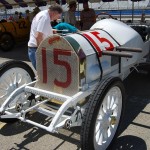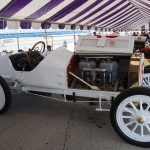

In 1950, Eldon Eby bought the rear section of a frame, a transmission and some unusual hubcaps while picking up a vintage car body in Jackson, Mich., At that time, Eby knew nothing of race driver “Wild Bob” Burman and the Cutting race car he drove in the 1911-1912 Indy 500s. Today, Eby races a re-creation of the car Burman wrecked in 1912 and wonders if his parts actually came from it.
It was Eby’s later purchase of a Wisconsin engine that perked his interest in Burman. The 599.5-cid four would have been the largest engine used in a 1912 medium-class racing car. The displacement limit in that class was 600 cu. in. “When I got the engine I knew nothing about the car,” Eby explained. “I just knew the engine was unique; I didn’t know what I was going to do with it, but I knew I was going to do something.” Three months later, Eby read an article by historian Jerry Gebby about Burman’s Wisconsin-powered Cutting.
This led Eby to do five years of research on Burman. The more he learned about him, the more fascinated he became. As someone once wrote, “When most people think of the early days of auto racing, they automatically think of Barney Oldfield, however, if you really take the time to investigate factual information, you would come up with an entirely different name—that of Bob Burman.”
“I found out the 1912 Cutting Burman drove in the second Indy 500 had a Wisconsin engine of unique design,” Eby explained. He then read in an early automotive trade publication that the Wisconsin-powered racing car had been built especially for Bob Burman by the Cutting Automobile Co.
In 1912, Burman ran into bad luck during the Indy 500. On the 157th lap his Cutting was in second, averaging 93.4 mph, when both rear tires blew and it crashed. Accounts of the day showed a picture of the wreck and said the car had flipped, but Eby believes this is incorrect; the rear of the car seen in a famous photo has no damage that’s consistent with flipping over. Burman was credited with 12th position in the race after the wreck.
Despite his setbacks, Burman won 33 of the 43 dirt track races he ran in 1912 and placed second eight times. This made him “Driver of the Year.” In 1913, Burman was flagged out of the Indy 500, but still moved up to 11th overall. In 1914, he teamed up with W. A. Thompson of Battle Creek Mich., who owned the Wisconsin Automobile & Machinery Co., of Milwaukee. In 1915, Burman worked with Harry Miller and Fred Offenhauser to improve the engine and reduce displacement to meet a new 5-liter Indy formula. Miller cast a 293-cid block and Offenhauser had his first chance to contribute directly to one of Miller’s designs. The Burman engine was the first known use of Miller’s “Alloyanum.”
On April 8, 1916, Burman was driving a 16-valve double overhead cam Peugeot when a tire blew. The open cockpit car flipped and killed him. “’Wild Bob’ Burman and Chicago Boy Die in Auto Crash,” reported the Chicago Daily Tribune on April 9, 1916. Burman, his riding mechanic Erie Schrader of Chicago, and track policeman W. H. Speer died and five spectators were injured in the tragedy that wound up the third Corona Road Race.
For years, Burman’s racing accomplishments were overshadowed by those of contemporaries like Oldfield and “Terrible Teddy” Tetzloff, but in 2011 Burman was inducted into the National Sprint Car Hall of Fame. Enthusiasts like Eby also began to notice Burman’s extensive list of wins and other accomplishements. Eby put together an exhibit featuring all Burman’s racecars.
Eby describes his 1912 Cutting as “A tribute to Bob Burman that I built because practically nothing survived of his career and very few people knew about him.” Eby discovered that Burman traveled the country in 1912 with both cars on a railroad car. He ran the Cutting in the under 600-cid class, while the Blitzen Benz raced in the Unlimted class for 600+ cid cars. Eby has driven the Cutting recreation at Indianapolis and at Michigan International Raceway, where he got it up to 91 mph. The car has appeared at the Harry A. Miller Meet at the Milwaukee Mile, in Milwaukee, Wis., for each of the past eight years.
While researching Burman, Eby ran across an advertisement in the July 16, 1914 issue of Motor Age magazine in which a race car was offered for sale in Jackson, Mich. The ad suggested that the car could be used to “make big money barnstorming” and described it as a 100-mph racecar. “If the ad was for the Cutting that Burman wrecked at Indy, it was actually a 120-mph car and probably wound up a barnstormer,” Eby told RacingJunk. “There are reports that Burman tested both the Blitzen Benz and the Cutting on country roads in the Jackson area and on trips to visit his parents, who continued to live in Imlay City.”
Eby points out that Burman’s car was originally designed to be aerodynamic. It was the first racing car to have a tapered tail. “At Indy, they found the car’s aerodynamic design did not let heat out, so they cut holes in the hood and put screens in,” says the long-time car collector. “They also took the wheel covers off the front wheels because they discovered that wind coming around the grandstand affected the steering; they also put a bump in the hood to allow airflow, but it wasn’t sufficient and they eventually removed the belly pan, too.”
After much research, the car was built to resemble Burman’s Cutting when it raced at Indy. It has spoke wheels up front and covered rear rims. The screened hood openings were made and there is no belly pan. Until he safety-wired them, Eby had problems with bolts and clips on the rear wheels loosening. He may have found why the wheels came off at Indy in 1912. “I’ve been collecting cars for over 60 years,” said Eby. “I started when I was a kid and I always wanted a 2-man Indy car. When I found out my parts might have been from Burman’s car, I had to do this.”






Leave a Reply